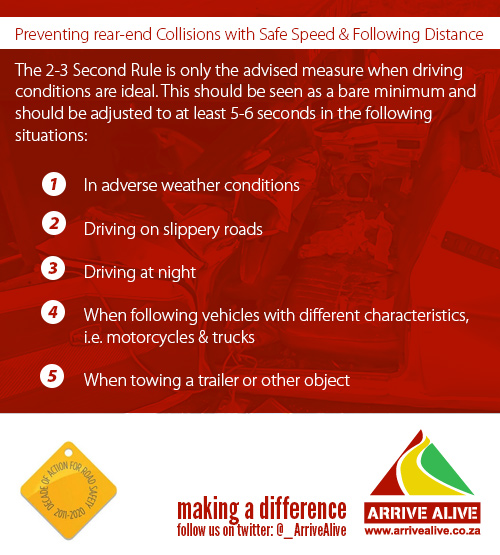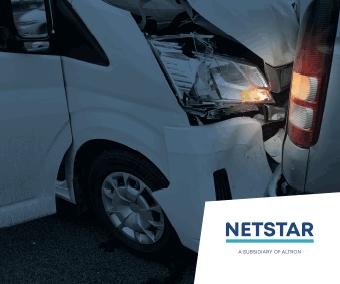“I get really stressed out when a car comes up from behind, leaving hardly any space between my back bumper and the front bumper of the other car. I don’t quite know what to do. I think it’s too dangerous to brake, even slightly, as it may cause the driver to crash into the back of my car. My braking may also trigger some road rage from the driver behind me and that I definitely don’t want. Maybe I should just flash my hazards to let the driver know he or she is too close.”
We hear accounts of tailgating, like above, on almost a daily basis. It is an infuriating and dangerous behaviour that is practised by many South African drivers.
You may have discovered already what tailgating is – it’s when a car drives too close behind the car in front of it. We are going to find out how we can avoid tailgating ourselves, and what to do when someone tailgates us.
REAR-END CRASHES
A 2015 article states that most rear-end crashes occur when drivers are following too closely behind another car. This type of driving is aggressive to say the least – the driver doing the tailgating is in a hurry and you just happen to be in the way! The driver would love to go over your car or even under your car if possible. The track is to stay calm if someone is tailgating you, because the last thing you want is to trigger road rage, which occurs so often on the South African roads today.
WHAT IS THE TOTAL STOPPING DISTANCE?
The total stopping distance of a car is made up of the following steps that occur during stopping:
- Time required for the brain to recognise that there is a serious problem lying ahead takes 0.75 seconds.
- Time taken for the brain to instruct braking of the car takes another 0.75 seconds.
- Time taken for the car to react is almost instantaneous – about 0.05 seconds.
- Time taken for the car to come to a complete stop, depends on how good the brakes and tyres are on the car, as well as the speed of the car at the time.
HAVING ENOUGH TIME TO REACT
It’s actually all about having enough time to react. The human brain can only interpret a certain situation and then proceed to give instructions in a limited amount of time. By allowing a reasonable, safe space in front of our cars, we are allowing our brains to work out things for us enough time. Although not part of this document’s topic, that is also the reason why we should always make changes slowly while we drive, like when we are changing lanes. If we move too fast, the other drivers will not be able to react in time, as their brains can only process the change so fast.
International studies have shown that if you are travelling 100 km/hr, and the car in front of you suddenly brakes, you have only a 1.5-second gap in which to brake – otherwise it is crash time!
So guess what – we have to really stay alert at all times. Cars in front of you may stop for an obstacle lying on the road, for pedestrians or animals, or for a distracted driver who may well be using a cell phone.
HOW MUCH SPACE SHOULD YOU LEAVE IN FRONT OF YOUR CAR?
In order to avoid tailgating, you as a driver must allow enough distance between your car and the car in front of you. If you are travelling at a speed of 60 km/hr, it means the car covers a distance of 17 m in 1 second! One second is not a long time, whilst 17 m is quite a distance. If the car suddenly brakes in front of you, you’ll reach that car’s rear end in no time. The average length of a car is about 4.5 m, so that is why the authorities warn us to maintain 3 cars’ lengths between your car and the one in front of you.
Another way of saying the above is: you must follow the 2- or 3-second rule as an international guideline for following safe distances.
HOW TO ADJUST FOLLOWING DISTANCE
The 2-3 second rule or having 3 car distances between your car and the one in front of you only applies in an ideal driving condition. The Automobile Association recommends making it into 5 or 6 seconds (or 5 to 6 car lengths) when the weather is bad, the road is wet, when driving at night, and when towing.
TAILGATING IS A TRAFFIC VIOLATION
Most South Africans do not have much of an idea of South Africa’s National Road Traffic Regulations. Perhaps road safety agencies should promote via TV adverts to re-educate all the motorists on what is lawful and what is not lawful. Over time, this would create an almost subconscious culture of safety amongst South African motorists.
Needless to say, you can get fined for tailgating.
WHAT DO YOU AVOID DOING WHEN YOU ARE BEING TAILGATED?
What do you do if someone comes out of the blue and cuts into the space in front of your car? Take a deep breath, put your pride in your pocket, start to slow down, and create some more space between you and the new arrival. Drive defensively and not aggressively.
When someone is really on the “tail” of your car, just drive defensively (not aggressively) by either getting out of the way by changing lanes (if that is possible) or just perhaps by decelerating and going slightly slower. This should encourage the driver to overtake you. Don’t brake as this could trigger road rage. Often drivers brake to try and get back at this irritating driver who would love to push you off the road. This behaviour is foolish for several reasons:
- First, this can cause a rear-end crash, especially if the driver behind you happens to be not alert. Would it really be worth it?
- This behaviour can also trigger serious road rage, which in severe cases can be fatal. Let’s be honest – we have no idea who the dude behind that wheel is – he or she could be drunk, have a gun, and so on the list goes on. We can’t afford such a confrontation, especially because we also put our loved ones (wife or kids) at great risk by behaving in this way. At times, the tailgater might chase you all the way to the border, if you aren’t careful.
So just move aside and let the driver go past you. Everyone can then breathe a sigh of relief, and start to enjoy the journey again.
Avoid the “Idiot Space” .. Maintain a Safe Following Distance https://t.co/3ODGMXBupF #ArriveAlive pic.twitter.com/NXdIkFNG7H
— Arrive Alive (@_ArriveAlive) December 23, 2016
Disclaimer:
This article was prepared by Eric Sandmann in his personal capacity. The views and opinions expressed in this article are the author’s own and do not reflect the views and opinions of Prime Meridian Direct (Pty) Ltd, FSP41040.The views and opinions in the article should not be attributed to anyone but the author unless expressly stated. Nothing in this article should be relied upon as advice, this publication is presented for informational purposes only. No person should act or refrain from acting in reliance on any information found in this article, without first obtaining proper financial advice from the appropriate professional. The author makes no claims, promises or guarantees about the accuracy, or completeness, of any information linked from, referred to, or contained in this article. The author reserves the right, to edit and change the content of this article.

























